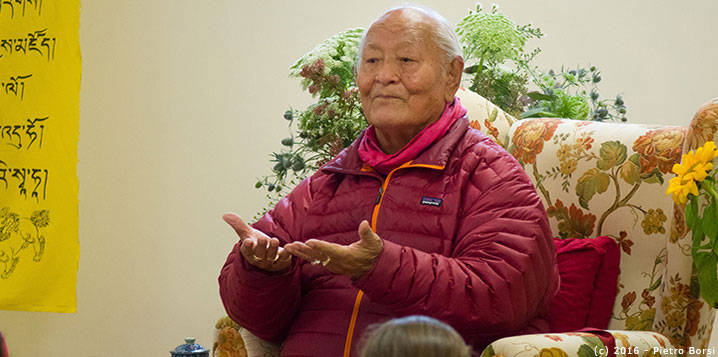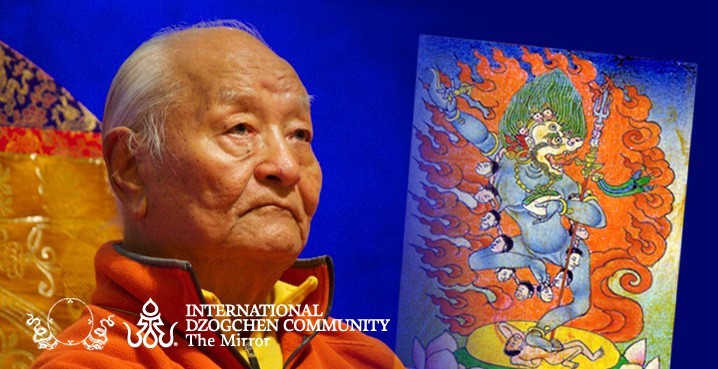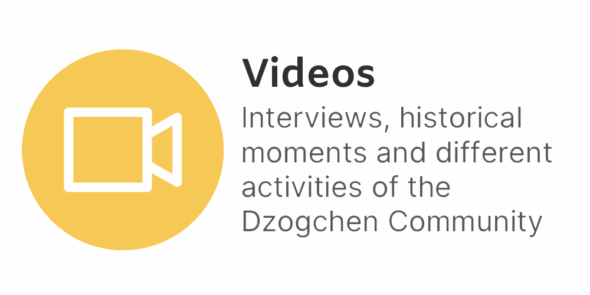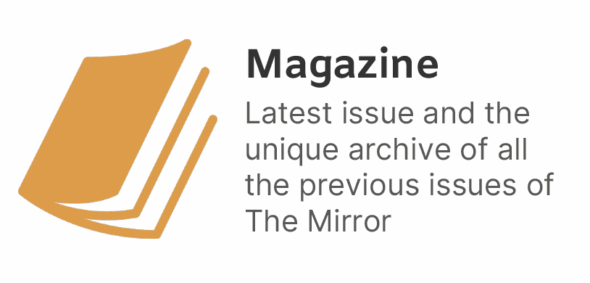Chögyal Namkhai Norbu
From The Song of the Vajra retreat, Hong Kong, 2012-05-17, day 2, part 2.
Continued from The Mirror no.164, June 2024.
One of the most important teachings that Garab Dorje gave is his Three Statements. For many years he transmitted Dzogchen teaching to his many students, including Manjushrimitra and, today, we have all these different kinds of Dzogchen Tantras that were taught by teachers from ancient times because they were repeated by Garab Dorje. He also gave teachings and explanations on Dzogchen that are not tantras but part of the Upadesha series, and so we have many precious original texts of Dzogchen teaching related with this kind of transmission. However, the conclusion of all his teachings are his Three Statements, which are like a key to the Dzogchen teaching.
The way in which teachers transmit [the teaching] to students and the way in which students learn and develop in order to be in the state of Dzogchen are connected to the Three Statements. This is something that we should understand from the beginning because a lot of people have the idea that the Dzogchen teaching consists of some special methods to be learned only after years of teachings and practices. Many Vajrayana teachers give this kind of advice to their students and tell them that they cannot learn Dzogchen directly, that they should learn Vajrayana, receive instructions, do practice and finally receive the Dzogchen teaching secretly from their teacher. They consider that Dzogchen is something special, something secret, but it is not like that.
Anuyoga and Dzogchen explain that we have nine vehicles. In the Nyingmapa tradition they say nine vehicles because originally they came from Anuyoga and Dzogchen. All these nine vehicles are independent; they do not depend on each other. For instance, in Hinayana one can have the realization of the Hinayana, of an arhat, although it is not easy to realizein a single lifetime. In Mahayana there is the realization of a bodhisattva for which one needs to do practice for many kalpas, many lives.
The vehicles are independent and their methods are different. Sometimes we consider Dzogchen to be a supreme or very high level of Vajrayana. When we compare it with the Sutra teaching we say that we can have realization in one lifetime with the Dzogchen teaching. A lot of people consider that this is a form of advertisement because in our dualistic condition there is a lot of that. For instance, one day they say that a particular soap is very good but tomorrow when they can’t sell it any more they change the box and give it another name saying that it is much better than others. However, the substance hasn’t changed. This is called publicity. But the teaching is not like that.
For instance, in the Sutra teaching practitioners have no knowledge of the energy level because there is no explanation of energy in Sutra. Vajrayana has always transmitted transformation and manifestation. Everything is related to the energy level so of course [Vajrayana practitioners] are very skilled at that.
We can understand this through the history of Tibet. In ancient times the Tibetan king Trisong Detsenwas a famous Dharma king and during his reign Dharma teachings were brought from India. He wanted this high level of teaching called Mahayana to come to Tibet and invited a very famous Mahayana teacher from India, Shantarakshita, who was also an expert in Madhyamika philosophy, to spread Buddhism there. However, Shantarakshita didn’t succeed because of the pre-Buddhist tradition, ancient Bön, which was concentrated on the five elements, the energy level, and the relationship between the elements. Most Tibetans were greatly influenced by the Bön tradition and when they tried to study the Buddhist Prajanaparamita they were not satisfied because there was no explanation of the energy level. When Shantarakshita discovered that, he decided to go back to India and suggested that they invite Guru Padmasambhava instead.
Guru Padmasambhava was an important Vajrayana teacher and very powerful in terms of everything related to energy and in the end the Bönpos followed him. He was also a great Dzogchen practitioner and for this reason he never tried to eliminate the Bön tradition but maintained its rituals although its substance changed within the Buddhist tradition.
That is one of the reasons why in the Western world when they refer to the Buddhist tradition of Tibet sometimes they call it “Lamaism” in a rather derogatory way. Why do they call it “Lamaism” when we are Buddhists? Because the Tibetan Buddhist tradition integrated many of the pre-existing Bön traditions in Tibet. For instance, when there are special days or an important lama is visiting, we burn sang incense powder to purify the dimension. This kind of sang ritual does not exist in the Buddhist tradition – there is not a single Sutra about Sang– but is an original tradition of the Bönpos.
We have a very famous Sangritual that all traditions use today, originally called sang nge composed by Guru Padmasambhava. Even the Gelugpas use it when they do the Sang offering. At the beginning of the ritual there are some verses that are characteristic of the Bönpo.
kyi/_bsang gi rgyu byung gang nas byung/
Hey, the cause originating Sang, where did it come from?
bsang gi rgyu byung gnam nas byung/
The cause originating Sang, it came from the sky.
pha gnam la ‘brug chen lda ma ldir/
In the sky, the father, great thunder roars forth,
ma sa la glog chen gya ma gyu/
on the earth, the mother, great lightning flashes forth.
In the Buddhist tradition there are no words that refer to “father sky” and “mother earth.” But in Dzogchen we can integrate everything. The most important thing is the real sense, not its aspect. The Vajrayana gives the example of gold that can be transformed into a wonderful statue but also into an ashtray although in the real sense the gold has not changed. The most important thing is that we discover the real sense, then we can integrate all the aspects. This is the reason why Guru Padmasambhava paid respect to and integrated Bön into the characteristic Buddhist tradition in Tibet.
The three kinds of transmission are very important. The most important one expressed in Garab Dorje’s first statement is direct introduction. Dzogchen teaching starts with direct introduction. It is not that as part of a Vajrayana teaching only the essence of Dzogchen is presented. It’s not like that. Dzogchen teaching is one of the nine vehicles; it is independent and does not depend on Tantra or on Sutra. Dzogchen has no limitations. If we need to use Vajrayana methods, Sutra methods, even other methods that are not Buddhist, we can apply them. But we must understand that Dzogchen is a complete path: we can start with Dzogchen, we can finish with Dzogchen. Some people may say that Dzogchen is too advanced for us, that we have no capacity, that we should follow Hinayana teaching. Each of the nine vehicles is independent, each vehicle has its own starting point and goal. Garab Dorje said that Dzogchen teaching starts with direct introduction. He never said we should start with Vajrayana transformation or that we should do Ngöndro, preliminary practices.
When I started to give Dzogchen teaching after a year or two I received a lot of criticism from many Tibetan lamas. They said that I was giving Dzogchen teaching without people doing preliminary practices. However, I didn’t feel guilty or that I had done something wrong because if it is really necessary to do preliminary practices Garab Dorje would have given four statements: the first statement would have been to do preliminary practices before direct introduction. We cannot say that Garab Dorje forgot that because he is a totally enlightened omniscient being who knows very well how we should apply the Dzogchen path. However, some teachers still follow the old traditional ways just as they did in Tibet and don’t understand the condition of sentient beings, particularly in the Western world. In the Western world most people have studied at elementary school and in many countries middle school is obligatory, so everybody interested in the teaching knows how to read and write. If they know how to read and write they also know how to think. For that reason when a teacher transmits a teaching he or she should transmit in different ways.
Today Tibet is becoming more modern and many people go to school and study. When I lived in Tibet in my youth, when I visited a village perhaps only one or two people at most could read and write. Yet even if they didn’t know how to read and write, people were faithful to the Dharma and had very great devotion. But devotion can become blind if people don’t understand that we need to follow teaching to try to understand the path. They go behind the names of the lamas and reincarnations and think that it is sufficient to simply see this reincarnation and receive a blessing in order to become realized. Some Tibetan lamas also have that kind of attitude and are ready to give blessings and protection cords and so on. Once these kinds of people have received a blessing – the lama puts something on their head, chants a mantra – and a protection cord, they are satisfied and go away. However, they cannot become realized that way.
I was born in Tibet and when I was young I studied in a monastery and later in college so I didn’t have time to be a reincarnation. When I finally started to be a reincarnation I went to a conference in China and then they asked me to teach in school. Later I returned to Tibet and met my teacher Changchub Dorje to receive teaching. After that I went to central Tibet then returned to Kham where there was a lot of confusion so I went back to central Tibet. When I finally arrived in India, I didn’t have time to be a reincarnation, sitting elegantly and giving blessings and protection cords. But years later when I went back to Tibet many Tibetans, particularly in my area, knew that I had the name of a reincarnation so they came to ask me for blessings and so on. People really wanted to receive protection cords but, at the time, I had nothing for making them. I finally managed to make the cords using strips of five or six of my shirts so when I left I only had one shirt.
However, I was quite unhappy about this kind of situation. In particular when some older people came I asked them to sit down for a while so that I could explain a little Dharma to them. They sat down and I explained in a very simple way about having good intentions in order to accumulate good actions, not about the state of Dzogchen, which they couldn’t understand. But they didn’t listen and just sat together talking to each other.
That is an example of not having the capacity to follow this kind of teaching so even though the teacher has compassion and wants to do something, he or she cannot do very much. This is why we say that Dzogchen teaching is for people who have high capacity. A lot of people think that high capacity means something like the realization of a mahasiddha who can have contact with the Sambhogakaya pure dimension. But in Dzogchen, high capacity doesn’t mean that.
In Buddha Shakyamuni’s Sutra teaching there is an explanation of the five capacities: tepa, tsöndrü, trenpa, tingedzin, sherab.First is your participation, your devotion, your interest. Most people are not interested [in the teaching]. For instance we can announce that there will be Dzogchen teaching, that the Dzogchen transmission is alive and is very important for everybody. We could even send out this information on television so that most people would hear about it. But when we do a retreat, how many people come compared to how many people there are in this city, for example? Why don’t they participate? Because they are not interested, this capacity of participation is missing.
The other capacities are related to participation so when someone has the capacity of participation or interest it should be combined with presence. If we are not present, even though we may be interested, we forget and the teaching never becomes something concrete. This is the second capacity.
We also need diligence because if we are not diligent the teaching does not become something concrete. In addition we need to understand the value of the state of contemplation. A lot of people do not have this understanding and think they are following teaching because they have learned a position or how to do some breathing, or they know how to visualize a deity and they are satisfied with that. But none of this has the value of the state of contemplation. Even if we are doing visualization of a deity, we may have some benefit but it never becomes the path to realization. We have to go beyond that. We should remember that at the end of transformation practice we dissolve the manifestation in ourselves and then remain in the state of emptiness or contemplation. That is something like the conclusion of the practice and we need to have this knowledge, the knowledge of the value of contemplation. This is the fourth capacity.
The fifth capacity is prajna, intelligence, because if we do not use our intelligence then even though the teacher explains time after time, we may not understand. Sometimes the teacher may use some words that we don’t know the meaning of, but using our intelligence we try to understand them or at least we listen once, twice, three times or more to try to understand their meaning.
These are the five capacities. When we have these kinds of capacities we can follow the Dzogchen teaching, apply it and understand how to receive the direct transmission, which is the first statement of Guru Garab Dorje.
The second statement of Garab Dorje is not remaining in doubt. This means that even though we may feel we have discovered [our real nature] it’s very difficult to feel one hundred percent sure of it. We can have this kind of problem not only for discovering our real nature but for any kind of practice we have learned and applied. However, we must not remain in doubt otherwise we cannot produce the function [of that practice]. In particular, when we discover our real nature we must be absolutely sure. In order to be sure there is the second statement of Garab Dorje. In Garab Dorje’s teaching there are many tantras, lungs, and upadeshas connected with that specific method.
The third statement means that when we have discovered [our real nature] and are absolutely sure, then we need to integrate and simply remain in that state forever, if possible. When we are learning and practicing, when we do Guruyoga just for a few seconds we are in that state. But when we practice day after day we become more and more familiar with it.
Particularly in Dzogchen, being in the state of Guruyoga is very easy because we don’t need to do anything particular. With Guruyoga there is no particular position or breathing or visualization. In a very simple way we instantly recall the presence of the white A and then we relax in that state. Just that is Guruyoga. We can do it many times during the daytime but for practitioners it is very important to do it at least when we wake up in the morning because being a Dzogchen practitioner means integrating that knowledge in our condition.
So the essence is Guruyoga. In daily life we have twenty-four hours in a day, so we do Guruyoga and go ahead trying to be present. When we feel like doing Guruyoga we can do it at any moment. Even if we do it many times, it is never too much. If we are forever in the state of Guruyoga we are realized. So this is what we should do.
I am not asking you to read a certain book, chant a particular mantra or sit in a special position. Doing Guruyoga means that you are in your real nature, it is not for supporting your teacher. Sometimes people think that since “Guru” means teacher, being in the state of Guruyoga means you are supporting your teacher, but it is not like that.
Guruyoga is for you, for your realization. Our day consists of twenty-four hours and we need to have an idea of integrating twenty-four hours in practice. How can we do that? It doesn’t mean only doing Guruyoga but also remaining present, not distracted, which, in Dzogchen, is a very important practice. If we are not distracted but always present, it is very easy to integrate in our state of Guruyoga. Being present is easy to do and we can practice it even when we are walking, working, speaking, and so on. It is much better if we are present and not distracted.
Edited by Liz Granger
Final editing by Susan Schwarz
Transliteration of the Sang offering by Prof. Fabian Sanders










